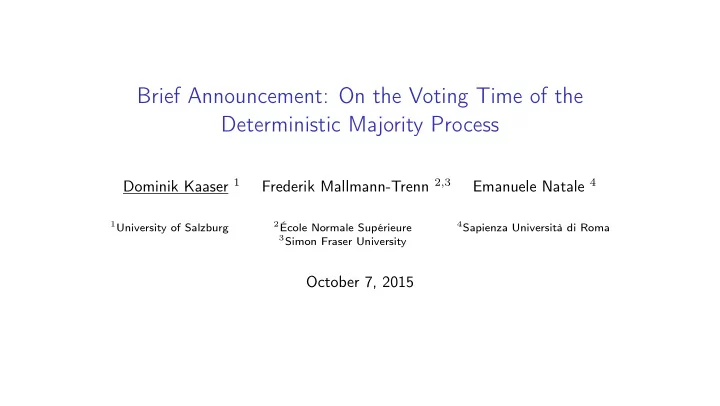

Brief Announcement: On the Voting Time of the Deterministic Majority Process Dominik Kaaser 1 Frederik Mallmann-Trenn 2 , 3 Emanuele Natale 4 1 University of Salzburg 2 École Normale Supérieure 4 Sapienza Università di Roma 3 Simon Fraser University October 7, 2015
Deterministic Binary Majority Voting Process ◮ given a graph G = ( V, E )
Deterministic Binary Majority Voting Process ◮ given a graph G = ( V, E ) ◮ initial opinion assignment f 0 : V → { 0 , 1 }
Deterministic Binary Majority Voting Process ◮ given a graph G = ( V, E ) f 0 ◮ initial opinion assignment f 0 : V → { 0 , 1 }
Deterministic Binary Majority Voting Process ◮ given a graph G = ( V, E ) f 0 ◮ initial opinion assignment f 0 : V → { 0 , 1 } ◮ process runs in discrete rounds
Deterministic Binary Majority Voting Process ◮ given a graph G = ( V, E ) f 0 ◮ initial opinion assignment f 0 : V → { 0 , 1 } ◮ process runs in discrete rounds ◮ every node adopts the majority opinion
Deterministic Binary Majority Voting Process ◮ given a graph G = ( V, E ) f 1 ◮ initial opinion assignment f 0 : V → { 0 , 1 } ◮ process runs in discrete rounds ◮ every node adopts the majority opinion
Deterministic Binary Majority Voting Process ◮ given a graph G = ( V, E ) f 2 ◮ initial opinion assignment f 0 : V → { 0 , 1 } ◮ process runs in discrete rounds ◮ every node adopts the majority opinion
Deterministic Binary Majority Voting Process ◮ given a graph G = ( V, E ) f 3 ◮ initial opinion assignment f 0 : V → { 0 , 1 } ◮ process runs in discrete rounds ◮ every node adopts the majority opinion
Deterministic Binary Majority Voting Process ◮ given a graph G = ( V, E ) f 4 ◮ initial opinion assignment f 0 : V → { 0 , 1 } ◮ process runs in discrete rounds ◮ every node adopts the majority opinion
Deterministic Binary Majority Voting Process ◮ given a graph G = ( V, E ) f even ◮ initial opinion assignment f 0 : V → { 0 , 1 } ◮ process runs in discrete rounds ◮ every node adopts the majority opinion
Deterministic Binary Majority Voting Process ◮ given a graph G = ( V, E ) f odd ◮ initial opinion assignment f 0 : V → { 0 , 1 } ◮ process runs in discrete rounds ◮ every node adopts the majority opinion
Known Results ◮ Goles and Olivos 1980, and Poljak and Sůra 1983: The process always converges to a two-periodic state.
Known Results ◮ Goles and Olivos 1980, and Poljak and Sůra 1983: The process always converges to a two-periodic state. ◮ Winkler 2008: The process converges after at most O ( | E | ) rounds.
Known Results ◮ Goles and Olivos 1980, and Poljak and Sůra 1983: The process always converges to a two-periodic state. ◮ Winkler 2008: The process converges after at most O ( | E | ) rounds. ◮ Frischknecht, Keller, Wattenhofer 2013: These bounds are tight.
Our Contribution Bounds on the Voting Time The voting time of the majority process is at most 1 + min { | E | − | V odd | / 2 , | E | / 2 + | V even | / 4 + 7 / 4 · | V | } .
Our Contribution Bounds on the Voting Time The voting time of the majority process is at most 1 + min { | E | − | V odd | / 2 , | E | / 2 + | V even | / 4 + 7 / 4 · | V | } . Exploiting Symmetries The voting time is bounded by the voting time in G ∆ obtained by contracting its families. A family is a set of nodes which share the same neighborhood.
Our Contribution Bounds on the Voting Time The voting time of the majority process is at most 1 + min { | E | − | V odd | / 2 , | E | / 2 + | V even | / 4 + 7 / 4 · | V | } . Exploiting Symmetries The voting time is bounded by the voting time in G ∆ obtained by contracting its families. A family is a set of nodes which share the same neighborhood. NP Hardness For a given simple graph G and an integer k , computing whether there exists an initial opinion assignment for which the voting time of G is at least k is NP-complete.
Applications Community Detection Compute convergence time for distributed community detection based on label propagation clustering algorithms (Raghavan, Albert, Kumara 2007)
Thank You for Your Attention — Questions Welcome! Introduction Related Work Our Contribution
Recommend
More recommend